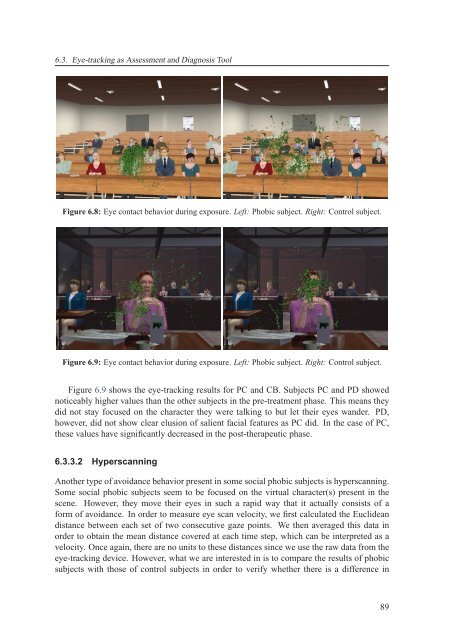Texte intégral / Full text (pdf, 20 MiB) - Infoscience - EPFL
Texte intégral / Full text (pdf, 20 MiB) - Infoscience - EPFL
Texte intégral / Full text (pdf, 20 MiB) - Infoscience - EPFL
You also want an ePaper? Increase the reach of your titles
YUMPU automatically turns print PDFs into web optimized ePapers that Google loves.
6.3. Eye-tracking as Assessment and Diagnosis Tool<br />
Figure 6.8: Eye contact behavior during exposure. Left: Phobic subject. Right: Control subject.<br />
Figure 6.9: Eye contact behavior during exposure. Left: Phobic subject. Right: Control subject.<br />
Figure 6.9 shows the eye-tracking results for PC and CB. Subjects PC and PD showed<br />
noticeably higher values than the other subjects in the pre-treatment phase. This means they<br />
did not stay focused on the character they were talking to but let their eyes wander. PD,<br />
however, did not show clear elusion of salient facial features as PC did. In the case of PC,<br />
these values have significantly decreased in the post-therapeutic phase.<br />
6.3.3.2 Hyperscanning<br />
Another type of avoidance behavior present in some social phobic subjects is hyperscanning.<br />
Some social phobic subjects seem to be focused on the virtual character(s) present in the<br />
scene. However, they move their eyes in such a rapid way that it actually consists of a<br />
form of avoidance. In order to measure eye scan velocity, we first calculated the Euclidean<br />
distance between each set of two consecutive gaze points. We then averaged this data in<br />
order to obtain the mean distance covered at each time step, which can be interpreted as a<br />
velocity. Once again, there are no units to these distances since we use the raw data from the<br />
eye-tracking device. However, what we are interested in is to compare the results of phobic<br />
subjects with those of control subjects in order to verify whether there is a difference in<br />
89

















